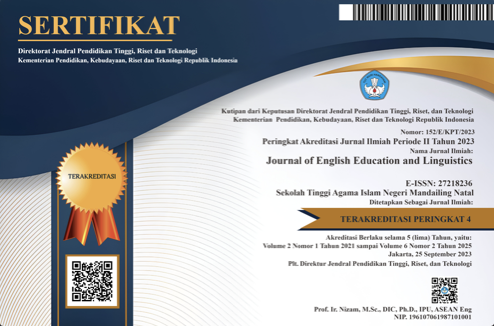THE IMPLEMENTATION OF THE FLYSWATTER GAME IN IMPROVING THE SEVENTH-YEAR STUDENTS’ VOCABULARY
DOI:
https://doi.org/10.56874/jeel.v5i1.1790Keywords:
Vocabulary mastery, Flyswatter game, junior high schoolAbstract
The purpose of this study is to determine whether teaching vocabulary using the Flyswatter game enhanced student vocabulary. The author used a flyswatter game as part of her action research in the classroom to find a solution. One cycle was used by the author in this study. Every cycle has four meetings. One class of twenty-four students participated in this investigation. The writer employed documentation, test sheets, and observation sheets as tools for gathering data. Based on the research findings, the students' progressive mean was displayed. The mean of the first meeting was 53.5; the second was 55.3; the third was 61.9; the fourth was 66.1 and the fifth was 75,5. As a result, the post-test mean was greater than the pre-test mean. The information collected from the observation sheet suggested that the pupils made progress. Research suggests that using the flyswatter game helps students' vocabularies. Finally, the flyswatter game may help SMPN 2 Tambangan students become more proficient in the language.
References
Ahyar, H., Maret, U. S., Andriani, H., Sukmana, D. J., Mada, U. G., Hardani, S.Pd., M. S., Nur Hikmatul Auliya, G. C. B., Helmina Andriani, M. S., Fardani, R. A., Ustiawaty, J., Utami, E. F., Sukmana, D. J., & Istiqomah, R. R. (2020). Buku Metode Penelitian Kualitatif & Kuantitatif (Issue March).
Ferawati, R. (2020). Using Fly Swatter Game to Improve The Students’ Vocabulary at the Eighth Grade of SMPN 8 Palopo. IAIN PALOPO.
Hiebert, E. H., & Erlbaum, L. (2010). The Teaching and Learning of Vocabulary: Perspective and Persistent Issues. Lawrence Erlbaum Associate (LEA).
Kemmis, S., & Mctaggart, R. (2005). Participatory action research. 559–603.
Lubis, S. W. D. (2020). THE ADOPTION OF FLY SWATTER GAME TO IMPROVE. UIN SUMATERA UTARA.
Ritonga, M., Febriani, S. R., Kustati, M., Khaef, E., Ritonga, A. W., & Yasmar, R. (2022). Duolingo: An Arabic Speaking Skills’ Learning Platform for Andragogy Education. Education Research International, 2022. https://doi.org/10.1155/2022/7090752
Sabana, S. (2019). The Implementation of Flyswatter Game to Develop Students’ Vocabulary at SMPN 5 Palopo (Issue 14). The State Islamic Institute Palopo.
Saputri, T. D. (2022). Teaching Vocabulary Using Fly Swatter Game at the Seventh Graders of Secondary School. EBONY: Journal of English Language Teaching, Linguistics, and Literature, 2(2), 1–8. https://doi.org/10.37304/ebony.v2i2.5274
Setiawan, B. (2010). Improving The Students’ Vocabulary Mastery Through Direct Instruction. Universitas Sebelas Maret.
Silaban, A. L. I., & Andriani, R. (2017). Using Fly Swatter Game to Improve Students’ Vocabulary Mastery at Grade Eigth SMP Dwi Sejahtera Pekanbaru. ELT-Lectura: Jurnal Pendidikan, 4(2), 36–41.
Solihin, R. K., Hartono, R., Rukmini, D., & Wahyuni, S. (2022). Penerapan Aplikasi Duolingo Sebagai Media Pembelajaran Dalam Keterampilan Menyimak Bahasa Inggris Siswa SMA. Prosiding Seminar Nasional Pascasarjana (PROSNAMPAS), 5(1), 949–954. http://pps.unnes.ac.id/prodi/prosiding-pascasarjana-unnes/ Penerapan
Susanto, A. (2017). THE TEACHING OF VOCABULARY : A PERSPECTIVE. Jurnal Kata, 182–191.
Syahrir, L., Sadapotto, A., Hermansyah, S., & Anwar, P. (2017). Improving Students Vocabulary Mastery by Using Fly Swatter Game at The Seventh Grade Students of SMPN 2 Kulo. Laogi: English Language Journal, 8(1), 35–39.
Thornburry, S. (2019). How To Teach Grmmar (Fourth). Longman.
Downloads
Published
Issue
Section
License
All articles published in the Journal of English Education and Linguistics are licensed under a Creative Commons Attribution-ShareAlike 4.0 International (CC BY-SA) license. This means anyone is free to copy, transform, or redistribute articles for any lawful purpose in any medium, provided they give appropriate attribution to the original author(s) and Journal of English Education and Linguistics, link to the license, indicate if changes were made, and redistribute any derivative work under the same license.
Copyright on articles is retained by the respective author(s) without restrictions. A non-exclusive license is granted to the Journal of English Education and Linguistics to publish the article and identify itself as its original publisher, along with the commercial right to include the article in a hardcopy issue for sale to libraries and individuals.
Although the conditions of the Creative Commons Attribution-ShareAlike 4.0 International (CC BY-SA) license do not apply to authors (as the copyright holder of your article, you have no restrictions on your rights), by submitting to the Journal of English Education and Linguistics, authors recognize the rights of readers and must grant any third party the right to use their articles to the extent provided by the license.

This work is licensed under a Creative Commons Attribution-ShareAlike 4.0 International License.








